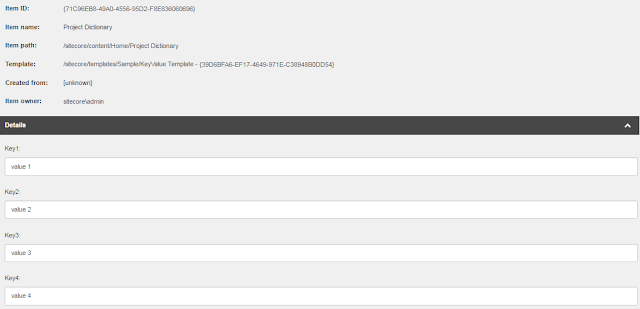This article focus on different ways for maintaining keys and values details in Sitecore. We will focus on advantages and disadvantages of every approach.
1. Sitecore Items
You can create Sitecore items which contain two fields
like Key and Value. Sitecore itself uses this technique for maintaining
dictionary values at /sitecore/system/Dictionary in CORE
database to keep standard messages as below
 |
| Dictionary item in Sitecore |
Advantage:
- You can keep Key as Share field and value as versioned/unversioned depend on requirement.
- It’s very easy to add a new fields in dictionary template apart from Key and Value field.
Disadvantages
- If there are large numbers of items, then it’s a performance overhead to process all the item and to find particular key and its value.
2. Sitecore Fields
Create template that contains different Single-Line text fields
where each field name act like a Key name and its data act like a value. One
need to create item for maintaining key's values as
 |
| Key-Value field |
Advantage
- Instead of processing hundreds of items, it’s very easy to process one item and gets values from its fields.
Disadvantage
- If you want to add a new key, then first add a field in template and then add its value to item. But remember, content editors generally don’t have access of template section.
3. Name Value List field
We rarely use this field but believe me this can be very
handy to maintaining key-value details.
Select field type as “Name
Value List” in template. While creating item, you can enter as many records
in name value details as
 |
| Name Value List Field |
How to access in code?
Use below code to get all the values of Name Value List as
string print = item["NameValueCollectionFieldName"];
print
variable return values separated by “&” such as
"key1=value%201&key2=value-2&key3=value_3&key4=value%204%20%26%20value%204.5&key5=value5"
As you can notice, key4 has value like “value 4 & value 4.5” which Sitecore
encoded in “value%204%20%26%20value%204.5”
just like we are encoding for query string.
Use below code to get individual key and value as
System.Collections.Specialized.NameValueCollection
nameValueCollection = Sitecore.Web.WebUtil.ParseUrlParameters(item["NameValueCollectionFieldName"]);
foreach(var nv in nameValueCollection)
{
print += "<BR>
Key Name=" + nv.ToString() + "-- Value=" +
nameValueCollection[nv.ToString()];
}
This loop print values like
//Key
Name=key1-- Value=value 1
//Key
Name=key2-- Value=value-2
//Key
Name=key3-- Value=value_3
//Key
Name=key4-- Value=value 4 & value 4.5
//Key Name=key5--
Value=value5
You can add new key and access values as
//Add
new key value pair
nameValueCollection.Add("newkeyName", "New key Value");
//Access
value from keyname
print += "<BR> " + nameValueCollection["key1"] + "^^^" + nameValueCollection["key9"];
In above statement, Key1 has value and key9 does not
exist. So this will give output as "value
1^^^". So this shows that it should not give any error for non-exist
key.
Advantage
- It’s very fast to access single item and single field for all the keys.
- You can cache value for this name value collection field and make it super-fast.
- If key is not present, you will not get the error :)
Disadvantage
- You can't add a new field if you want to hold any other details apart from key and value details.
I hope developer will try to use NameValue field in their
assignments.
I hope you like this Sitecore article. Stay tuned for
more Sitecore related articles.
Till that happy Sitecoring
:)
Please leave your comments or share this article if it’s
useful for you.

Thanks dude.
ReplyDelete